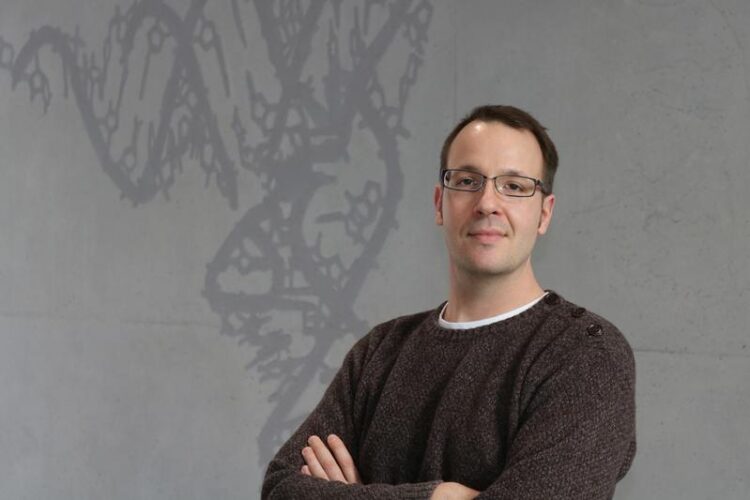New findings in genome research

After completing his doctoral thesis in the field of epigenetics, Philipp Rathert spent four years in industrial research. He developed methods for investigating epigenetic processes.
Photo: Rathert
The working group around Dr. Philipp Rathert at the Institute for Biochemistry and Technical Biochemistry investigates the regulation of epigenetic networks of certain cancers and ways of treating them. The working group published its new findings in April.
Epigenetics research is a relatively young discipline in biology. Epigenetic mechanisms regulate which genetic information is used when and how. They play an important role in controlling the activity of genes. The epigenetic modifications control the gene activity individually in each individual cell and the causal relationships between the various processes are complex and have not yet been fully understood.
In various diseases, e.g. in certain types of cancer, the epigenetic processes are disturbed. The gene expression programs controlled by epigenetic modifications are carried out incorrectly and, under certain circumstances, abnormal cell growth occurs. Recent advances in genome analysis show that mutations in enzymes responsible for these modifications are particularly common in cancer. The research of the working group led by Dr. Philipp Rathert at the Institute for Biochemistry and Technical Biochemistry focuses on this area. In their publication in Nucleic Acids Research, the scientists describe their results on the regulatory mechanisms surrounding the enzyme LSD1.
New Approaches to Treating Diseases
Epigenetics not only offers new approaches to understanding disease processes, but also new approaches to treat them. “The diagnosis of diseases via certain epigenetic modifications and the therapy of these diseases using inhibitors against epigenetic regulatory enzymes have become indispensable in medicine,” explains Dr. Philipp Rathert.
Protein networks regulate gene activity highly specific
A central question is how the proteins and enzymes that are involved in the regulation of epigenetic processes interact with each other in order to switch genes on or off at the right time and thus establish and maintain a healthy cell condition. Most enzymes work in large molecular complexes with a huge number of protein subunits. Viewed on their own, these subunits exercise a specific function, and in the complex also regulate one another. In addition, different complexes influence each other. In this way, complex regulatory protein networks are created that regulate gene activity very specifically.
Research aiming towards the understanding of complex epigenetic regulatory networks
The Stuttgart based scientists are investigating how the complex epigenetic regulatory networks that control several thousand genes communicate with one another. Up until now, the connections within these epigenetic networks could only be explained with great difficulty. In order to better understand these relationships and ultimately to identify innovative therapeutic strategies and / or novel biomarkers, the working group uses a variety of genetic instruments. State-of-the-art functional genetic engineering (RNAi or CRISPR) is combined with fluorescence-based reporter systems that are integrated into the genome of cells. In this way, the researchers analyze the function of individual subunits of various complexes. In the current publication, Philipp Rathert’s group describes a novel approach to the investigate the regulatory network of the histone demethylase LSD1.
Studies of an enzyme that offers an approach to cancer therapy
he enzyme LSD1 has emerged as a possible target for the development of cancer drugs in the recent years, especially for leukemia and lung cancer. But why the inhibition of LSD1 is effective in some types of cancer and hardly shows any effects in others is still relatively unclear and probably related to the composition of the regulatory network around LSD1.
To investigate this more closely, the team established a novel fluorescence-based reporter system that can analyze LSD1 activity in living cells. Thanks to the innovative combination of the reporter system with an RNAi screening process, the Stuttgart researchers were able to characterize a comprehensive set of epigenetic coregulators and identify new regulators of LSD1 activity. The subsequent analysis of the biological function provided evidence of a novel gene regulatory mechanism of LSD1. This information deepens the understanding of the development of cancer and provides information about possible new angles for the development of combination therapies.
The biochemist Rathert is convinced that the research and use of epigenetic information and its complex regulatory pathways will make a key contribution to the understanding of biological processes in the future.
Originalpublikation:
Pinter, Sabine; Knodel, Franziska; Choudalakis, Michel; Schnee, Philipp; Kroll, Carolin; Fuchs, Marina; Broehm, Alexander; Weirich, Sara; Roth, Mareike; Eisler, Stephan A; Zuber, Johannes; Jeltsch, Albert; Rathert, Philipp. (2021) A functional LSD1 coregulator screen reveals a novel transcriptional regulatory cascade connecting R-loop homeostasis with epigenetic regulation. In: Nucleic Acids Research, Volume 49, Issue 8, 7 May 2021, Pages 4350–4370, https://doi.org/10.1093/nar/.
Media Contact
All latest news from the category: Life Sciences and Chemistry
Articles and reports from the Life Sciences and chemistry area deal with applied and basic research into modern biology, chemistry and human medicine.
Valuable information can be found on a range of life sciences fields including bacteriology, biochemistry, bionics, bioinformatics, biophysics, biotechnology, genetics, geobotany, human biology, marine biology, microbiology, molecular biology, cellular biology, zoology, bioinorganic chemistry, microchemistry and environmental chemistry.
Newest articles

“Nanostitches” enable lighter and tougher composite materials
In research that may lead to next-generation airplanes and spacecraft, MIT engineers used carbon nanotubes to prevent cracking in multilayered composites. To save on fuel and reduce aircraft emissions, engineers…

Trash to treasure
Researchers turn metal waste into catalyst for hydrogen. Scientists have found a way to transform metal waste into a highly efficient catalyst to make hydrogen from water, a discovery that…

Real-time detection of infectious disease viruses
… by searching for molecular fingerprinting. A research team consisting of Professor Kyoung-Duck Park and Taeyoung Moon and Huitae Joo, PhD candidates, from the Department of Physics at Pohang University…





















